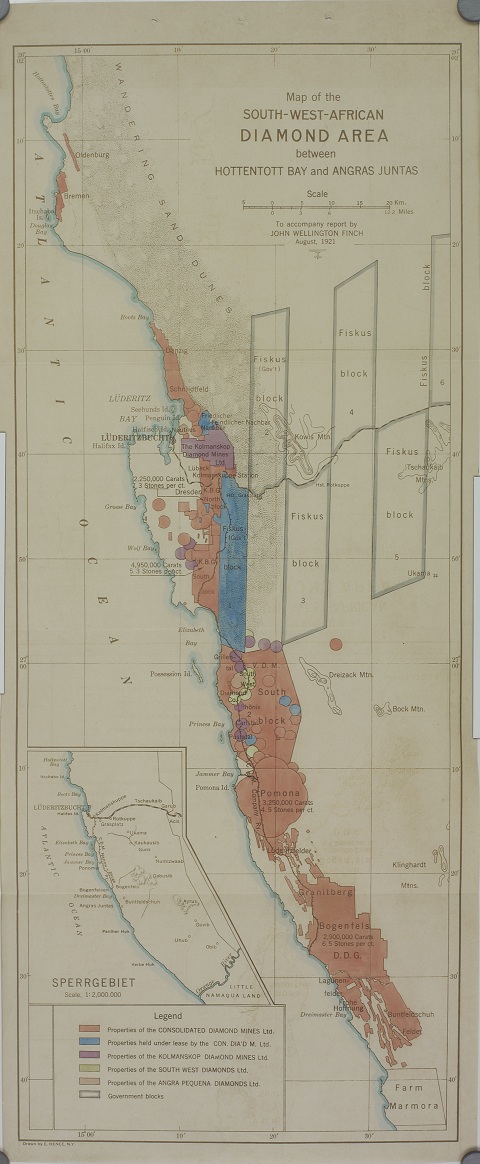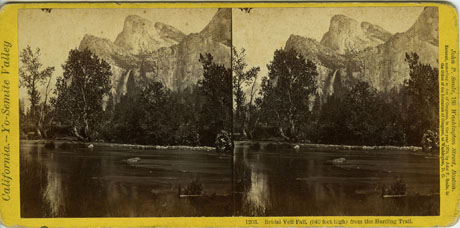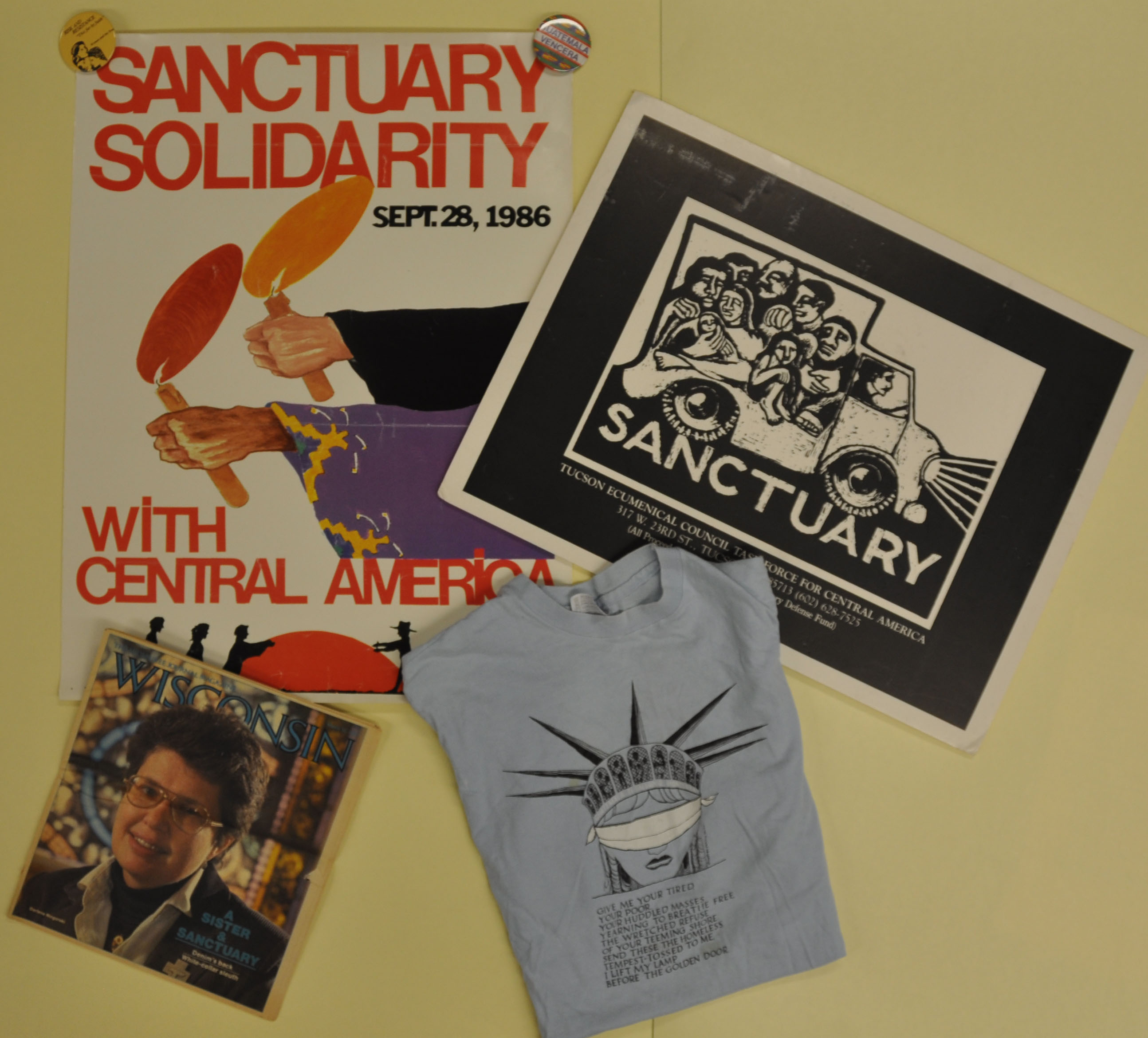
Honnold/Mudd Special Collections holds materials from all over the world. This map of the diamond regions of what is now Namibia is part of a report compiled in 1921 for Consolidated Diamond Mines of South West Africa, Ltd. (since 1994 Namdeb Diamond Corporation), founded by Mr. (later Sir) Ernest Oppenheimer.
The report is part of the papers of William Lincoln Honnold (1866-1950), mining engineer and together with Oppenheimer co-founder of Anglo American Corporation. Born in Illinois, Honnold lived in South Africa from 1902 until 1915, when he moved to London to serve as London director of his friend Herbert Hoover’s Committee for Relief of Belgium (in 1917, he returned to the United States to serve as New York director for the same organization). Upon retiring in the early 1920s, Honnold moved to California, where he and his wife, Caroline, became dedicated supporters of higher education, in particular Caltech and the Claremont Colleges. Honnold was a member of the first Board of Fellows of Claremont College, and also served as a member of the Pomona College Board of Trustees. He and his wife provided the funds to build Honnold Library. Honnold was also a close friend and colleague of the Mudd family, some of whose papers are also in Special Collections.
The Honnold papers contain a wealth of papers and photographs documenting mining in the United States and Southern Africa in the late 19th and early 20th centuries, life in Southern California in the 1920s and 1930s, famous individuals such as Oppenheimer and Hoover, and the history of the Claremont Colleges. The collection is currently being processed, and a finding aid will be available shortly.
Hazeltine stereoscopic views of Yosemite

The Martin Mason Hazeltine stereoview collection was recently purchased by Special Collections, Honnold/Mudd Library and its finding aid listing titles of all items can be viewed at the Online Archive of California.
Fifty-three stereoviews, plus one duplicate, of Yosemite Valley and the California Big Trees scenic views. All marked with the studio imprint of John P. Soule. This “California” series of photographs was produced by the photographer Martin Mason Hazeltine (1827-1903), though no credit is given him on these images. Hazeltine, a Vermont native, moved to California and established a studio in Mendocino in the late 1860s. Among his works, he produced many western images, including this Yosemite series, and one on the Yellowstone. His photos were published by other firms, including J. P. Soule, and Lawrence & Houseworth.
Darlene Nicgorski papers

The papers of Darlene Nicgorski, a leader of the Sanctuary movement for Central American refugees in the United States in the early 1980s, have been processed by Honnold/Mudd Special Collections staff, and a finding aid is now available online at the Online Archive of California (OAC).
Darlene Nicgorski was born and educated in Wisconsin. She first became involved with the people of Central America in 1980, when, as a member of the School Sisters of St. Francis, she answered the call to help members of her congregation in Guatemala set up a preschool program there. Forced to flee Guatemala after the assassination of her mentor, Padre Tulio, barely six months after her arrival, Sister Darlene, while visiting her family in Phoenix, Arizona, became involved with the Sanctuary movement. The Sanctuary movement, which at its height in 1985 had approximately 500 member sites across the United States, had begun in 1980, when a handful of residents of Tucson, Arizona, in violation of United States law, began providing legal, financial, and material aid to Central American refugees. In March 1982, on the second anniversary of Archbishop Oscar Romero’s assassination, the Rev. John Fife declared his congregation, the Southside Presbyterian Church in Tucson, the first public sanctuary in the United States. In 1983, Sister Darlene was asked by the Chicago Religious Task Force on Central America to coordinate the movement of refugees to Sanctuary congregations throughout the country. Less than two years later, the Immigration and Nationalization Service cracked down on the Sanctuary Movement, and in January 1985, Sister Darlene was among 16 arrested and charged with 71 counts of conspiracy and encouraging and aiding illegal aliens to enter the United States. The trial in Tucson, which attracted considerable national attention, ran from October 1985 to May 1986. Sister Darlene was convicted of conspiracy to violate immigration law and two counts each of transporting and aiding and abetting the harboring of illegal aliens. Facing a maximum sentence of 25 years in prison, she was given a suspended sentence and five years’ probation.
A popular spokesperson for the Sanctuary movement since her arrest, Sister Darlene fulfilled over 200 speaking engagements between 1985 and 1988. She also received many awards, including Ms magazine’s 1986 Woman of the Year, the American Civil Liberties Union of Northern California’s Earl Warren Civil Liberties Award for 1986, and the Women’s Ordination Conference Prophetic Figure Award for 1987. She was the first Roman Catholic to receive Union Theological Seminary’s Union Medal.
After the trial, Sister Darlene relocated to Massachusetts, where she continued to write about her experiences from a feminist faith perspective. After increasingly questioning the Roman Catholic Church’s attitudes regarding sexuality and women, she left the School Sisters of St. Francis in 1987. After leaving the religious life, Nicgorski held positions as a teacher and educational consultant; she retired in 2011 after 22 years in human resources. She and her life partner, Chris, plan to move to Claremont in the near future.
Darlene Nicgorski’s papers comprise writings, correspondence, newspaper and periodical clippings, legal papers, flyers, programs, photographs, audiotapes and videotapes, and graphic and other materials relating to her life and career. The materials fall into three broad groups:
The materials documenting the trial of Nicgorski and her co-defendants in Federal District Court in Tucson, Arizona (the “Arizona Sanctuary Trial”), their conviction and sentencing, and their unsuccessful appeal to the 9th Circuit Court of Appeals (1985-1989) include relatively few court documents, or documents relating to the defendants as a group, but focus on Nicgorski and her defense, prepared and undertaken by Michael Altman. Especially noteworthy are the original microcassettes and transcripts of Nicgorski’s daily reflections on the course of the trial; her statements to attorneys and the other defendants, and her public statements during the trial; and interviews of Nicgorski and several witnesses by defense counsel Michael Altman. Other significant materials include post-conviction letters concerning Nicgorski addressed to Judge Carroll for his consideration when determining her sentence; a large number of letters of support addressed to Nicgorski; and two extensive collections of clippings from newspapers and periodicals, one prepared by Nicgorski herself, the other by the Sanctuary Defense Fund’s media office.
Materials documenting Nicgorski’s involvement with the Sanctuary movement (1981-1987) include studies, flyers, pamphlets, and special issues of periodical publications, that investigate and report on the issues confronting refugees from Central America, their attempts to escape repression in their homeland, the movement in the United States to provide asylum and sanctuary for these refugees, United States government policy on Central America, and the actions of the Immigration and Naturalization Service. Materials of particular significance include audiotaped interviews in the early 1980s with refugees; photographs documenting Nicgorski’s work in Central America and with Central American refugees in Arizona; and extensive records–including some audiotapes and videotapes–of Nicgorski’s speaking engagements. Other significant materials include publicity, programs, and liturgies for prayer and worship services for the movement; the Freedom Train Sanctuary caravan from Phoenix to Northampton, Massachusetts, in the summer of 1987; posters, newspaper political cartoons, and other graphics concerning the movement; and writings by, and correspondence with, others working with Central American refugees.
Materials documenting Nicgorski’s relationship with the order of School Sisters of St. Francis (1970-1987) include a substantial number of records relating to the order’s support for the Sanctuary movement and for Nicgorski during her trial. Among these records are official letters of support from the order, private letters from individual members of the order, and a detailed media packet that carefully summarizes Nicgorski’s life, the circumstances that led Central Americans to seek refuge in the United States, the Sanctuary movement, and the Roman Catholic Church’s support for the movement. Materials documenting Nicgorski’s personal relationship to the order include her profession, personal papers, and materials relating to her 1987 separation from the order.
The Darlene Nicgorski papers, while documenting an important 20th century social movement, also have special contemporary relevance in a time when Arizona, the birthplace of the movement welcoming political refugees from Central America, is now at the heart of the heated debate on the problem of illegal immigration, and when the social activism of Roman Catholic women religious is being criticized by the church hierarchy. We thank Darlene Nicgorski for sharing the records of her experiences with us, and invite anyone interested in using the collection to sign on to Aeon, our new Special Collections Request System, and click on the “Register as a reader and make your Reading Room requests” button), to access the collection.